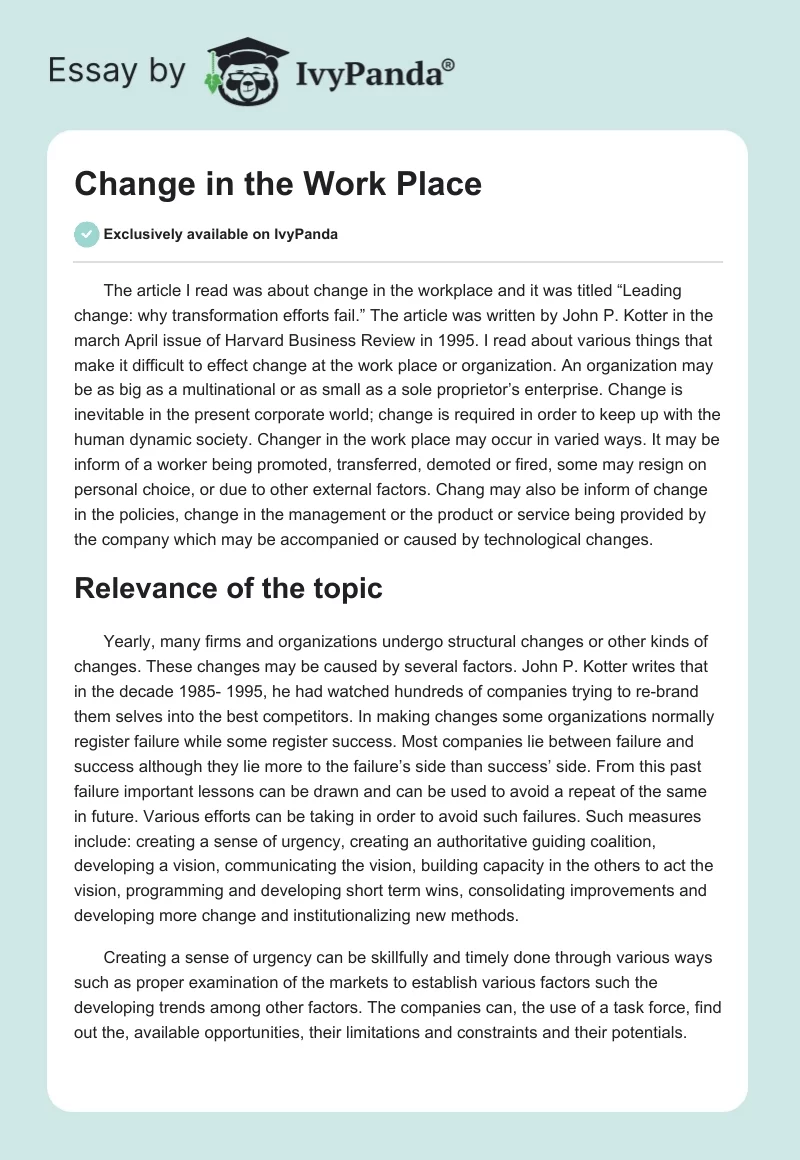The article I read was about change in the workplace and it was titled “Leading change: why transformation efforts fail.” The article was written by John P. Kotter in the march April issue of Harvard Business Review in 1995. I read about various things that make it difficult to effect change at the work place or organization. An organization may be as big as a multinational or as small as a sole proprietor’s enterprise. Change is inevitable in the present corporate world; change is required in order to keep up with the human dynamic society. Changer in the work place may occur in varied ways. It may be inform of a worker being promoted, transferred, demoted or fired, some may resign on personal choice, or due to other external factors. Chang may also be inform of change in the policies, change in the management or the product or service being provided by the company which may be accompanied or caused by technological changes.
Relevance of the topic
Yearly, many firms and organizations undergo structural changes or other kinds of changes. These changes may be caused by several factors. John P. Kotter writes that in the decade 1985- 1995, he had watched hundreds of companies trying to re-brand them selves into the best competitors. In making changes some organizations normally register failure while some register success. Most companies lie between failure and success although they lie more to the failure’s side than success’ side. From this past failure important lessons can be drawn and can be used to avoid a repeat of the same in future. Various efforts can be taking in order to avoid such failures. Such measures include: creating a sense of urgency, creating an authoritative guiding coalition, developing a vision, communicating the vision, building capacity in the others to act the vision, programming and developing short term wins, consolidating improvements and developing more change and institutionalizing new methods.
Creating a sense of urgency can be skillfully and timely done through various ways such as proper examination of the markets to establish various factors such the developing trends among other factors. The companies can, the use of a task force, find out the, available opportunities, their limitations and constraints and their potentials. This finding could be useful on whether to go ahead and exploit these opportunities markets or not.
Creating an authoritative guiding coalition may involve formation of a team of competent persons to spearhead the change. The group should further be given incentives to work together as a team in order to achieve the designated goal within the time stipulated.
In development of a vision and communicating the vision it worthy noting that the vision provides the appropriate direction for the change therefore there is great need of developing strategies aimed at achieving the visions. The vision should then be communicated appropriately to employees who can further be thought about it.
Building the capacity of the staff members to take action should is by keenly eliminating the obstacles to change and getting rod of the present systems and structures that are likely to undermine the vision developed. It requires courage to undertake and embrace non traditional ideas and activities. Therefore the employees should be encouraged to take risks.
Programming and developing for predictable improvements should be done and workers who participate in the activities can be encouraged by good salaries in order to keep providing the labor and ideas.
Consolidating improvements and producing more changing requires that the new findings are incorporated by changing of the present structures and policies to soot the vision appropriately. Workers may be promoted or educated in order to fit in the new system appropriately. Some new workers may be hired too.
Institutionalizing the change ensures developing a link between the new development and the joint success and ensuring leadership development and succession.
Why changes don’t succeed
From the method that can be used to institute change arises the reason for failure if any of the steps is not appropriately handled, for instance, not creating a sense of urgency may make the workers reluctant and thus not achieve the change required. Secondly if there is no authoritative guiding coalition and a vision which is well communicated the workers lack proper guidance and goals to achieve. Guidance and a vision helps create the sense of direction which is otherwise lacking when this two (guidance and vision) are missing. If a vision is present, then it should be communicated effectively so that each worker can understand it appropriately. Lack of communication makes change difficult.
Lack of capacity in the workforce to handle the change is also a limiting factor that stands in the way of change. Workers can’t handle something they don’t understand. They will just spoil it. Once there is no capacity to handle change, programming and developing new wins will become very hard. If the, organization manages to handle the earlier steps but does not develop new wins then the change will still fail.
Consolidation of improvements and producing more change is also another very important step which should be handled very carefully. Failure to equip workers with skills to handle this stage or employ professional’s staff to handle it may spell doom. and finally the changes made should be institutionalized to become successful. Failure to institutionalize their change may amount to failure
Reference
John P. Kotter (1995) “Leading change: why transformation efforts fail.” Harvard Business. 2008. Web.


